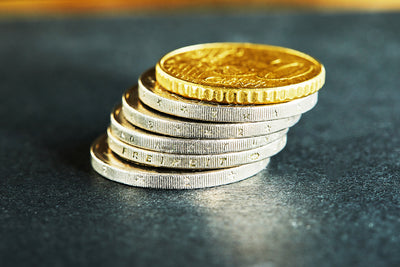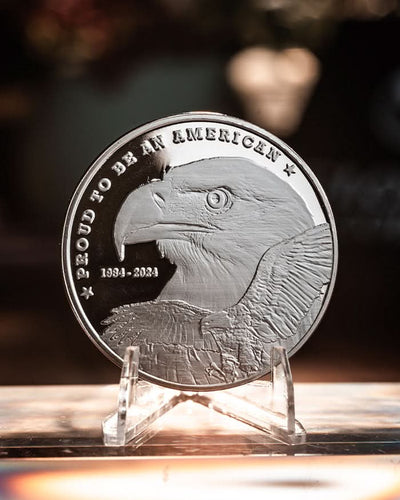Fake Coins: Counterfeit Gold and How to Avoid It
Key Points
-
Counterfeit gold is a significant problem, with seizures like $1 million worth in 2023 by US Customs.
-
Fake graded coins from China are sold on eBay and AliExpress, often at low prices, tricking buyers.
-
Counterfeiters use gold-plating, tungsten, and fake labels to deceive.
-
Authenticity is crucial for gold investing to protect wealth.
-
Verify gold with weight checks, magnet tests, and professional appraisals.
-
Grading services like PCGS help, but watch for fake labels.
-
Buy from reputable dealers, check reviews, and watch for online red flags like low prices.
-
Technology like blockchain and XRF fights counterfeiting.
What You Need to Know About Counterfeit Gold
Counterfeit gold is a big deal for investors, with modern-day scammers, or "pirates," selling fake gold to steal your wealth. In 2023, US Customs seized over $1 million in counterfeit gold jewelry, showing how widespread the issue is. It's especially risky online, where fake graded coins from China are sold on platforms like eBay and AliExpress at suspiciously low prices, often mimicking rare coins with fake PCGS or NGC labels.
How they trick you includes gold-plating base metals, using tungsten (which feels like gold), forging, and creating fake hallmarks or grading labels. This matters because gold is your safety net during tough times, like inflation, but fake gold means you're losing money instead of protecting it.
To spot fakes, check the weight (gold has a specific density), use a magnet (gold isn't magnetic), or get a professional to appraise it. Grading services like PCGS help, but ensure the label is real by checking photos for holograms. Buy from trusted dealers, look for good reviews, and watch for red flags online, like prices too good to be true or sellers with no feedback.
New tech is fighting back, with blockchain tracking gold's journey and XRF machines checking its makeup without damage. Stay safe by being cautious and informed.
Fake Coins: Counterfeit Gold and How to Avoid It

This detailed analysis explores the threat of counterfeit gold in today's market, examining its scale, examples of fake graded coins, common counterfeiter tactics, the importance of authenticity in gold investing, verification methods, the role of grading services, tips for buying authentic and from reputable dealers, red flags when buying online, and technology innovations combating counterfeiting. It aims to provide a thorough understanding for investors, supported by examples and practical advice, ensuring a balanced view for both seasoned and novice readers.
Understanding Gold

Gold is a valuable and highly sought-after precious metal, often used in jewelry, coins, and other decorative items. Its value lies in its rarity, durability, and aesthetic appeal. Gold is a dense, non-reactive metal that is resistant to corrosion and tarnish. This makes it an ideal material for items that need to withstand the test of time, such as heirloom jewelry and investment-grade coins. Additionally, gold is a good conductor of electricity and heat, which is why it is also used in various industrial applications.
Gold is often alloyed with other metals to increase its strength and durability, making it more suitable for everyday wear. For example, pure gold (24K) is quite soft and can be easily scratched or bent, so it is commonly mixed with metals like copper, silver, bronze or nickel to create more durable alloys. These alloys not only enhance the metal’s strength but also allow for a variety of colors, such as white gold or rose gold, adding to its versatility and appeal.
Defining Counterfeit Gold and Its Implications
Counterfeit gold refers to fake gold products, such as counterfeit coins, bars, or jewelry, that are made to appear genuine but are not made of gold or have lower gold content than advertised. This can include false gold-plated items, alloys with minimal gold, or entirely fabricated coins with fake hallmarks or grading labels. The implications are significant, as counterfeit gold can lead to financial loss for investors, erode trust in the precious metals market, and undermine gold’s role as a safe-haven asset during economic uncertainty.
For example, if an investor buys a counterfeit gold bar thinking it’s 1 ounce of 99.9% pure gold, but it’s actually tungsten with a gold plating, they could lose thousands of dollars, especially during inflationary periods when gold is sought for wealth preservation.
Types of Counterfeit Gold
Counterfeit gold can take many forms, including fake gold jewelry, coins, and bars. Counterfeiters often use base metals like copper, zinc, or nickel to create fake gold items, which can be difficult to distinguish from real gold. Some common types of counterfeit gold include:
-
Gold-Plated Items: These are made by applying a thin layer of real gold to a base metal. While they may look like real gold, the underlying metal is usually of much lower value.
-
Gold-Filled Items: These are created by bonding a thin layer of real gold to a base metal using heat and pressure. Although they contain more gold than gold-plated items, they are still not solid gold.
-
Rolled Gold Plate: This type of gold-plated item is made by applying a thin layer of real gold to a base metal using a rolling process. It is similar to gold-filled items but typically contains even less gold.
-
Vermeil: This is a type of gold-plated item that involves applying a thin layer of real gold to a base metal, usually silver. While vermeil items are of higher quality than other gold-plated items, they are still not solid gold.
Understanding these different types of counterfeit gold can help you make more informed decisions when purchasing gold jewelry, coins, or bars.
Physical Properties of Genuine Gold

Genuine gold has several physical properties that can help identify it as real. These include:
-
Density: Gold is a dense metal, with a density of 19.3 g/cm³. This high density is one of the key characteristics that set gold apart from other metals.
-
Color: Gold has a distinctive yellow color, although it can also be alloyed with other metals to create different colors, such as white gold or rose gold.
-
Non-Reactivity: Gold is non-reactive, meaning it does not corrode or tarnish easily. This property makes it ideal for long-term storage and use in jewelry.
-
Ductility: Gold is a ductile metal, meaning it can be easily shaped and molded without breaking. This property allows gold to be crafted into intricate designs.
-
Malleability: Gold is a malleable metal, meaning it can be easily hammered and shaped. This makes it perfect for creating thin sheets or detailed engravings.
These physical properties are essential for identifying genuine gold and distinguishing it from counterfeit items made of other metals.
Understanding the Scale of Counterfeit Gold in Today’s Market

While exact figures are generally hard to come by due to the secretive nature of counterfeiting, reports and seizures indicate that counterfeit gold and fakes are a significant issue:
-
Prevalence: The World Gold Council acknowledges counterfeiting as a concern, particularly in online marketplaces where oversight is minimal. Industry estimates suggest up to 10% of gold coins sold online might be counterfeit, though this lacks precise sourcing.
-
Seizures and Arrests: Law enforcement agencies regularly seize counterfeit gold. For instance, in 2022, Hong Kong customs seized counterfeit gold worth HK$1.2 million, and in 2023, the US Customs and Border Protection seized over $1 million worth of counterfeit gold jewelry (United Nations Office on Drugs and Crime).
-
Online Platforms: Platforms like eBay and AliExpress are hotspots, with counterfeiters exploiting lax verification. A blog post by a precious metals dealer estimates significant counterfeit activity, though without specific statistics, highlighting the need for caution.
This scale underscores the importance of vigilance, as counterfeit gold and fakes can infiltrate both retail and investment markets, affecting individual and institutional investors.
Examples of Fake Graded Coins Made in China and Sold on eBay
Fake graded coins from China are a common scam on online marketplaces, often advertised as rare or valuable but counterfeit:
-
AliExpress Wholesale Graded Coins: AliExpress offers wholesale graded coins at low prices, likely counterfeit, as seen in their section for wholesale graded coins (AliExpress). These are often listed with grades like MS65, but lack verification.
-
Reddit and Collecting Forums: Users on X and collecting forums, like Coin Talk, report receiving fake PCGS and NGC-graded coins from Chinese sellers on eBay and AliExpress, with posts showing images of fake holders and labels (CoinTalk).
-
Specific Cases: A Reddit post detailed a user receiving a fake PCGS-graded coin, and another forum post showed fake NGC holders, indicating a pattern of sophisticated counterfeiting targeting collectors.
These examples serve to highlight the need for buyers to verify the authenticity of graded coins, especially from online sources, as counterfeiters mimic reputable grading services.
Common Tactics Used by Counterfeiters

Counterfeiters employ various methods to deceive buyers, making it crucial for investors to be aware:
-
Gold-Plating: Covering base metals, like copper or brass, with a thin layer of gold to mimic the appearance of pure gold, often used for jewelry or coins.
-
Mixed Metals: Using alloys that contain some gold but are not of the stated purity, such as 10K gold sold as 24K, reducing value significantly.
-
Tungsten Substitution: Using tungsten, which has a similar density to gold, to create fake gold bars or coins, making them pass weight checks but failing purity tests, as seen in reports of tungsten-filled bars (Royal Canadian Mint).
-
Fake Hallmarks and Stamps: Counterfeiting official stamps or hallmarks, like those from the London Bullion Market Association (LBMA), to make items appear genuine, often seen in online listings.
-
Fake Grading Labels: Creating or altering grading labels from reputable services like PCGS or NGC, including fake holders with holograms and serial numbers, as reported in collecting forums.
These tactics are becoming more sophisticated, with counterfeiters using advanced manufacturing to mimic real gold products, necessitating robust verification methods.
Why Authenticity Matters More Than Ever in Gold Investing
In today's economic climate, marked by inflation, geopolitical tensions, and market volatility, gold is increasingly seen as a safe haven investment. However, counterfeit gold undermines this role, leading to financial loss and missed opportunities for wealth creation and preservation. For example, during the 2020 economic uncertainty, gold prices rose to over $2,000 per ounce, but buying counterfeit gold would mean losing out on this appreciation.
Authenticity ensures that the gold you invest in has the expected value, protecting against scams and maintaining trust in the market. With online sales booming, the risk of counterfeiting has grown, making authenticity checks more critical than ever for investors seeking to safeguard their wealth.
How to Verify the Purity of Gold Coins and Bars

To ensure you’re buying genuine gold, use these verification methods, each with practical steps:
-
Weight Check: Compare the weight of the gold item to its expected weight based on size and stated purity. For example, a 1-ounce gold coin should weigh 31.1035 grams. Use a precise scale, as discrepancies can indicate tungsten or other substitutes.
-
Magnet Test: Gold is not magnetic, so if a magnet sticks, it’s likely not pure gold. This is a quick initial check, but note that some alloys might not react either, requiring further tests.
-
Float Test: Drop the gold item into water to see if it floats or sinks. Real gold will sink due to its density, while fake items might float. However, further testing may be necessary as other metals can behave similarly.
-
Acid Test: Use nitric acid to test for gold presence. Real gold won’t react, while base metals will, changing color. This should be done by professionals to avoid damaging the item, as seen in tutorials from the Federal Trade Commission.
-
Scratch Test: Scratch the surface of a testing stone to see if the color changes, indicating gold-plating. Compare with known gold samples, but this is less reliable for modern counterfeits.
-
Professional Appraisal: Have the gold item appraised by a reputable dealer or use X-ray fluorescence (XRF) machines, which non-invasively determine composition, commonly used by jewelers and mints (Royal Canadian Mint).
Testing gold using advanced techniques, such as XRF machines, provides a more accurate assessment of the item's authenticity and quality. While DIY tests can offer initial insights, professional appraisals from jewelers or precious metal refineries are recommended for reliable results.
These methods, combined, provide a robust way to verify purity, with professional appraisal offering the highest accuracy.
The Role of Grading Services in Preventing Counterfeit Risks

Grading services like the Professional Coin Grading Service (PCGS) and Numismatic Guaranty Corporation (NGC) play a crucial role by authenticating and grading coins, providing assurance of genuineness through encapsulated holders with security features. However, counterfeiters have created fake graded coins, necessitating vigilance:
-
Authentication Process: PCGS and NGC use experts to verify coins, checking for weight, design, and metal composition, with holders featuring holograms, unique serial numbers, and tamper-evident seals (PCGS).
-
Counterfeit Risks: Fake holders with replicated labels are common, as seen in reports on X and collecting forums, requiring buyers to verify the grading service's authenticity by checking serial numbers online.
-
Purchase from Authorized Dealers: Buy graded coins only from authorized dealers or directly from PCGS/NGC to ensure legitimacy, reducing the risk of counterfeit holders.
This role is vital, but investors must ensure the grading is genuine, as fake graded coins are a growing scam.
Tips for Buying Gold from Reputable Dealers
To minimize the risk of purchasing counterfeit gold, follow these tips:
-
Research the Dealer: Look for dealers who are members of professional organizations like the American Numismatic Association (ANA) (ANA) or the Industry Council for Tangible Assets (ICTA), ensuring credibility.
-
Check Reviews: Read customer reviews on platforms like Trustpilot and check for any complaints with the Better Business Bureau (BBB) (BBB), looking for consistent positive feedback.
-
Ask for Guarantees: Ensure the dealer offers a guarantee of authenticity and a return policy, providing recourse if the item is counterfeit, as seen with reputable dealers.
-
Inspect the Item: If possible, inspect the gold item in person before buying, or have it inspected by a professional, checking for hallmarks and weight, as advised by Federal Trade Commission.
-
Verify Credentials: Ensure the dealer is licensed and insured, if applicable, and has transparent contact information, reducing the risk of scams.
These steps help ensure you're dealing with a trustworthy source, protecting your investment.
Red Flags to Watch for When Buying Gold Online
When buying gold online, be cautious of the following red flags:
-
Prices that are too good to be true: If the price is significantly lower than market value, it's likely a counterfeit, as seen with listings on AliExpress offering graded coins at half the price.
-
Sellers with no or negative feedback: Avoid sellers with little to no history or poor ratings on platforms like eBay, as this indicates potential risk, reported in X posts and forums.
-
Lack of clear contact information: Legitimate dealers should have transparent contact details, such as a phone number and physical address, not just an email, as advised by Better Business Bureau.
-
Pressure to buy quickly: Counterfeiters often use high-pressure tactics, like limited-time offers, to rush purchases without proper verification, a common scam tactic.
-
No return policy or guarantee: If the seller doesn't offer any guarantees or return options, it's a red flag, as reputable dealers typically provide these.
Recognizing these red flags can help investors avoid scams, especially in online environments.
Technology Innovations Fighting Counterfeit Gold Coins

Advanced technologies are being deployed to combat counterfeiting, enhancing security for investors:
-
Blockchain: Companies like Everledger use blockchain to track the ownership and authenticity of gold items, creating an immutable record, as seen in their gold supply chain initiatives (Everledger).
-
X-ray Fluorescence (XRF): Non-invasively determines the composition of gold items, used by jewelers and mints, with portable devices available for quick testing, as reported by Royal Canadian Mint.
-
QR Codes and NFC Tags: Some gold products now come with QR codes or NFC tags linking to authenticity certificates, enhancing verification, as seen with branded bullion from the Perth Mint (Perth Mint).
-
Machine Learning: AI-powered systems analyze images or data to detect counterfeit gold, with startups developing apps for smartphone-based verification, as discussed in Forbes.
These innovations are making it harder for counterfeiters to attempt to succeed, providing investors with tools to verify authenticity more effectively.
Conclusion and Investment Implications
Counterfeit gold poses a significant threat to investors, with modern-day pirates using sophisticated tactics like fake graded coins and tungsten bars to steal wealth. By understanding the scale, recognizing common scams, and using verification methods like weight checks and professional appraisals, investors can protect themselves. Buying from reputable dealers, watching for online red flags, and leveraging technology like blockchain and XRF can further safeguard investments. Stay informed and cautious to ensure your gold is genuine, preserving your wealth in an increasingly risky market.
Common Mistakes to Avoid
When buying or selling gold, there are several common mistakes to avoid:
-
Not Testing the Gold: It’s essential to test the gold to ensure it’s real and not counterfeit. Simple tests like the magnet test or more advanced methods like X-ray fluorescence can help verify authenticity.
-
Not Checking the Gold Content: Make sure to check the gold content of the item, as some items may be gold-plated or gold-filled. Knowing the exact gold content can prevent you from overpaying for an item.
-
Not Buying from Reputable Dealers: Only buy from reputable dealers who can provide certification and guarantees. This reduces the risk of purchasing counterfeit gold.
-
Not Storing Gold Properly: Gold should be stored in a cool, dry place to prevent damage and corrosion. Proper storage ensures that your investment retains its value over time.
By avoiding these common mistakes, you can make more informed decisions and protect your investment in gold.
Protecting Your Investment
To protect your investment in gold, it’s essential to take several precautions:
-
Storing Gold in a Safe Place: Consider storing your gold in a safe deposit box or a home safe. This protects your gold from theft and damage.
-
Insuring Your Gold: Consider insuring your gold against loss or theft. Insurance provides financial protection in case your gold is stolen or lost.
-
Keeping Records: Keep records of your gold purchases, including receipts and certification. This documentation can be crucial for verifying authenticity and value.
-
Monitoring Market Prices: Keep an eye on market prices to ensure you’re getting a fair deal. Understanding market trends can help you make better buying and selling decisions.
-
Selling to Reputable Dealers: Only sell your gold to reputable dealers who can provide a fair price and certification. This ensures that you receive the true value of your gold.
By taking these steps, you can safeguard your gold investment and ensure that it retains its value over time.








Leave a comment
This site is protected by hCaptcha and the hCaptcha Privacy Policy and Terms of Service apply.